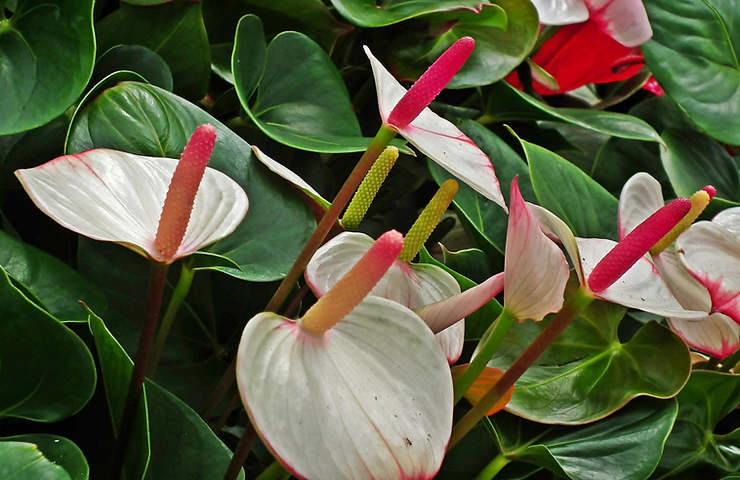How to Care for Anthurium – Both Inside and Outside
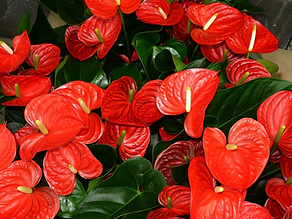
You probably know it as the Flamingo Flower, Laceleaf, Tailflower, or Painter’s Pallette. Actually, its true name is Anthurium. Its name comes from the Greek words anthos and oura, meaning flower and tail respectively. The tail refers to the spadix of the plant protruding from the center of the “flower”. Regardless of what you call it, it is a beautiful tropical plant that always reminds me of soft Hawaiian breezes. Read on to learn how to care for Anthurium both inside and out in the garden.
(Some of the links within this post are affiliate links on which I receive a small compensation from the sale of certain items with no extra cost to you.)
(As an Amazon Associate I earn from qualifying purchases.)
A Few Facts About the Anthurium Plant
Anthurium is in the family Araceae and has over 1000 different species. The beautiful heart-shape is not a flower, it actually is a spathe. A spathe is a a form of leaf that protects and surrounds the spadix, which is the flowering spike protruding from the spathe. For more information on the biology of a spathe, click on the Brittanica website.
An individual Anthurium bloom can last for 8 weeks. The plant will likely bloom year round if given the right conditions and attention. Anthurium flowers come in shades of red, pink, purple, orange, white and black.
Due to the long blooming time, the Anthurium is considered a wonderful hospitality gift.
Anthurium is a natural air purifier that removes pollutants from enclosed areas.
Beware, its beauty is deceiving. The plant is toxic to animals, pets, and humans. It can irritate the mouth, throat, and intestinal lining if ingested. If the sap comes in contact with the skin it can cause an allergic reaction.
Warning: Keep Anthurium away from pets and children to protect them from accidentally ingesting or touching the plant.
Inside or Outside?
If you live in USDA zones 11 or 12 and have a high humidity factor, you can plant your Anthurium outside. Follow the instructions below to simulate its natural habitat.
If you live in a colder zone, you can bring the beauty of the tropics inside your home during the colder months and then place it outside in the summer.
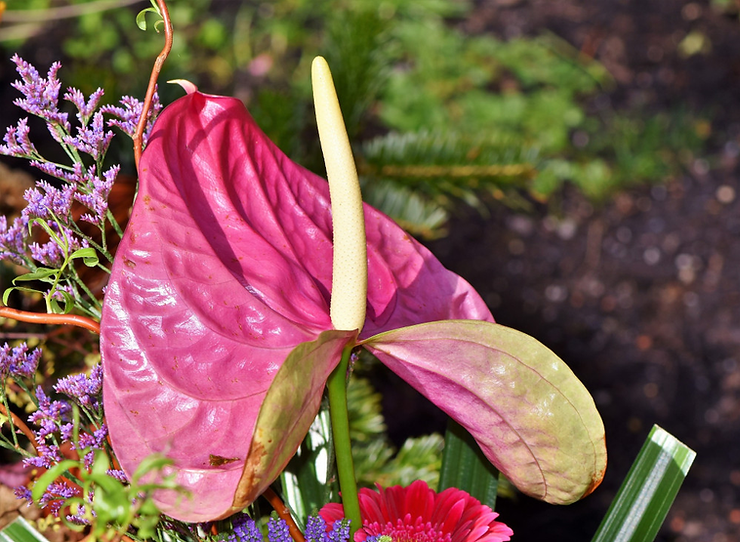
How to Care for Anthurium
Anthurium is a common houseplant and is relatively easy to care for if you follow some tried and true rules.
Light
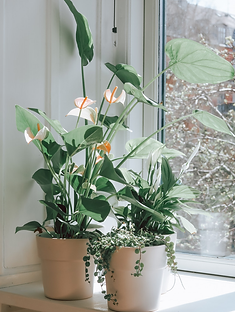
The Anthurium plant is an epiphyte, similar to an orchid, so it prefers indirect, bright light. It is naturally found under a canopy of trees with filtered sunlight in a tropical forest.
In your home, place the plant in an east or west facing room close to a window where the sun’s rays are less intense. A southern window will provide too strong light.
The key to enhance blooming is to provide it with consistent moderate sunlight and fertilizer. When the central spike begins to turn brown, clip the stem off at the base.
Your plant will grow much slower and not produce flowers if it does not receive enough light. However, Anthurium plants will survive in a low-lit area.
Potted Anthurium plants love to be placed outside in a shaded area in the summer. This is an easy way to beautify your outdoor living space. For more information on moving houseplants outside for the summer months, click here.
Water Requirements
Water the Anthurium plant when the top one inch of the soil is dry. You can determine this by sticking your finger into the soil. If it comes out dry, it’s time to water. Add water to the soil until it drains from the bottom. Poking the soil with a Phillips head screwdriver or any pointed object will help break up the soil and allow the roots to soak up the water. Do not puncture the soil too close to the base of the plant.
It is important to monitor the water especially during the spring and summer months when the plant is actively growing. If the plant is outside and you are experiencing a drought, the Anthurium will need to be watered every 2 to 3 days. However, do not overwater it because its roots are prone to root rot.
Signs of water deprivation and stress include if the leaves become droopy and begin to pucker. Also, the plant will be light in weight when lifted.
The plant will not require nearly as much water in the winter months when growth considerably slows.
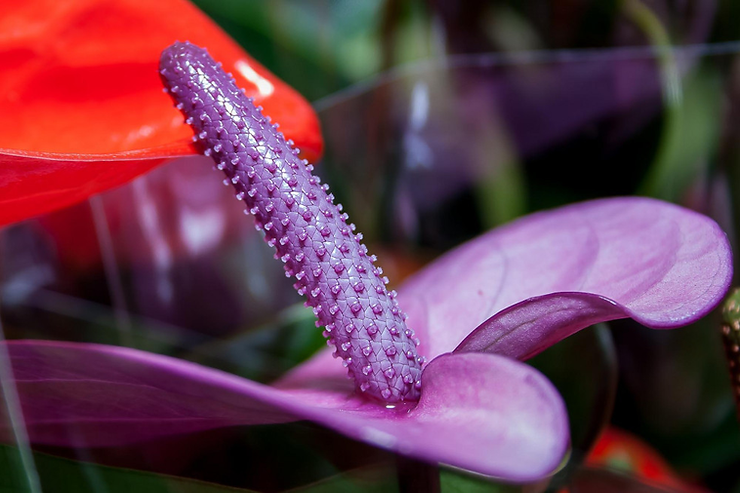
Soil
Because the Anthurium plant is an epiphyte, it does not necessarily need soil to grow. Epiphytes survive on moisture from the air and nutrients from their host plants. If you are considering transplanting your Anthurium plant, use a cactus soil which is not nearly as heavy as a regular potting soil mix. This type of soil will allow for proper, quick, drainage. If you do not have cactus soil, mix your potting soil with materials such as wood chips, perlite, coarse sand, or pumice to aerate the soil.
It prefers a soil acidity between 5.5 and 6.5 pH.
Fertilize/Blooms
It is best to fertilize the Anthurium plant weekly with a liquid fertilizer high in phosphorous during the growing season. Dilute the fertilizer to 1/4 its strength. This will encourage the plant to bloom year round at 3 month intervals.
If your plant is not blooming, it may be receiving too much water creating soggy soil, not receiving enough light, or it may be rootbound, in which case you’ll need to repot it. The growth of the Anthurium plant will be stunted if it is root bound.
Repotting
1. Choose a clean, sterile pot 1 to 2 inches wider in dimeter than the plant’s current pot.
2. Fill the pot with the soil mentioned above leaving an indentation in the center in which to place the root ball.
3. Remove the plant from its originate pot and gently untangle its roots.
4. Place it in the soil, cover the roots, and gently press down on the roots filling in any air pockets. You may need to hold the base of the plant with one hand while distributing the soil around its roots to prevent it from sinking too deep into the soil. The crown of the plant (area where the plant begins to grow) should be even with the soil level.
5. Water the plant and top it off with more soil if necessary
Temperature and Humidity
The Anthurium plant is a tropical plant and grows outside in zones 11 and 12. In order to grow a healthy plant inside, mimic its natural environment.
A temperature between 65 degrees and 85 degrees F is ideal. Do not keep the plant outside if temperatures fall below 60 degrees.
They prefer a lot of humidity. Therefore if you are growing a plant inside, be sure to place it where the humidity is high by clustering indoor plants together and placing them on a bed of gravel where water will accumulate and eventually evaporate. As an alternative you can place an Anthurium in a bathroom or the kitchen if it has the proper lighting. Both rooms usually have a good amount of humidity.
If the humidity in your house diminishes in winter months, mist the plant daily. You may have to add a humidifier near the plant if you see the plant is not receiving enough humidity.
Do not place Anthurium next to an AC or heating vent.
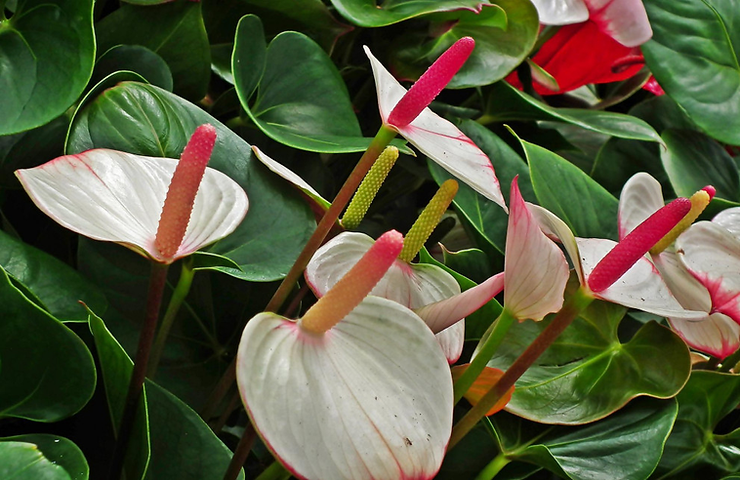
Pruning
It is best to cut off dead, yellowing leaves at the base of the plant. Once the flower has browned, it too should be removed by cutting the stem at the base of the plant. By pruning off the dead leaves and flowers, the plant will focus its energy on producing more leaves and blooms.
Trim any wild leaves that render the plant assymetrical, not very shapely, and looking off balance. You want a nice evenly rounded plant. Do not drastically trim it. Leave at least 4 or 5 original leaves on the plant.
Propagate
Anthurium plants will need to be propagated when they do not produce any more blooms, or if you just want another plant. The plant will actually start propagating itself by producing “air roots”. These roots will look tuberous and bumpy and protrude above the soil line.
1. Gather a new sterile pot and sharp knife along with the soil described above. You can also add a rooting hormone if you desire but it is not necessary.
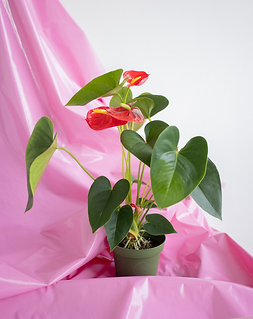
2. Choose either an “air root” or a 6 inch stem with 2 to 3 sets of leaves and cut it off using your sharp instrument. Dip the cut end in the hormone rooting solution if you’d like.
3. Place the cut end of the air root or stem in the potting soil. Keep the soil moist and in indirect light. The cutting will begin to root and produce new growth within 4 to 6 weeks.
Mature Size
The Anthurium grows slowly, growing only 4 inches per year. It will also grow as a creeper if given the opportunity.
It will grow to around 30 inches tall and 9 to 12 inches wide. If their “air roots” are left to expand and have a support structure on which to grow, it can creep up to 12 to 15 feet tall.
Final thoughts/How to Care for Anthurium Plants
These plants can be a little tricky to cultivate especially for a beginner gardener. However, if you are patient and follow the directions above, you will become a master gardener of Anthurium plants in no time! Enjoy your tropical experience by taking a chance and growing an Anthurium plant.
I hope you enjoyed this post. Please leave a comment below and let me know how you made out. Also, share this article and others on my website with friends and family.
Happy Gardening!
Nina

